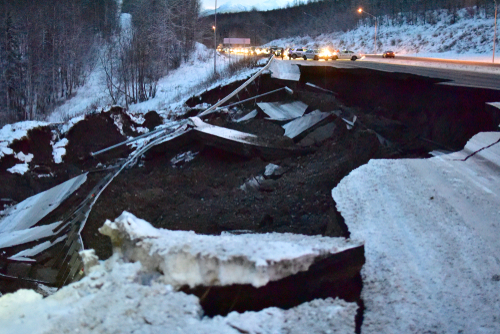Alaska earthquake: When will the aftershocks stop?
Two days after a magnitude 7.0 earthquake struck near Anchorage, Alaska is still shaking.
Since Friday’s tremor, the strongest to strike The Last Frontier since a 7.9 in the remote Rat Islands in 2014, the U.S. Geological Survey has recorded 166 aftershocks of magnitude 3.0 or higher around Anchorage as of 4:50 p.m. PST Sunday, USGS geophysicist Brad Aagaard told USA TODAY. Earthquakes of 3 or higher are strong enough to be felt.
There have been hundreds of smaller disturbances: 1,406 aftershocks of at least magnitude 1.0.
The aftershocks will occur less frequently as time goes on, Aagaard said. Over the next week, the USGS has predicted 84 to 610 aftershocks of magnitude 3 or higher. Aftershocks of at least 3 are more than 99 percent likely. There’s an 88 percent chanceof a magnitude 5 or higher, too.
An aftershock stronger or as strong as the initial one is unlikely, however. The probability for an earthquake of magnitude 7 or higher before Dec. 8 is only 3 percent, said the USGS.
The location of the earthquake – near the subduction interface at a depth of 25 miles beneath the surface – raised the threshold for what magnitudes are felt at the surface, Aagaard said. The subduction zone is the place where two lithospheric plates come together, one riding over the other, according to the USGS.
“If this had been a much shallower one, people really would be feeling a lot more aftershocks,” Aagaard said. “So that is probably helping to some extent, in terms of people not feeling as many aftershocks, because they are occurring deeper.”
USGS starts with generic models to predict aftershocks, Aagaard said, then makes adjustments as they monitor aftershocks on the first day. Its scientists are updating forecasts on a daily basis and making weekly projections, the time range in which they have the most confidence.
“As we get farther into the sequence, then we can have a better fit to our models to be able to see when we expect to get to the background rate,” Aagaard said. “That’s what we compare against, which is how many earthquakes we have in an area when we haven’t had a large earthquake and aftershock.”
Meanwhile, delivery of food supplies, fuel and other cargo has not been interrupted, Anchorage officials said at a Sunday news conference.
At the Port of Anchorage, through which 90 percent of all goods sold in Alaska come, at least one major cargo company is unloading as normal. Ships are coming in on schedule and the supply lines are not interrupted, said Mayor Ethan Berkowitz.
The earthquake Friday disrupted power and heavily damaged the only highway running north of Anchorage.
As crews make repairs to Glenn Highway, employees living north of Anchorage were encouraged to take Monday off or work from home to reduce traffic. Gov. Bill Walker gave state office workers in the Anchorage area Monday off.
The magnitude 7.0 quake, maybe remarkably, did not cause widespread damage to structures or collapse buildings.

